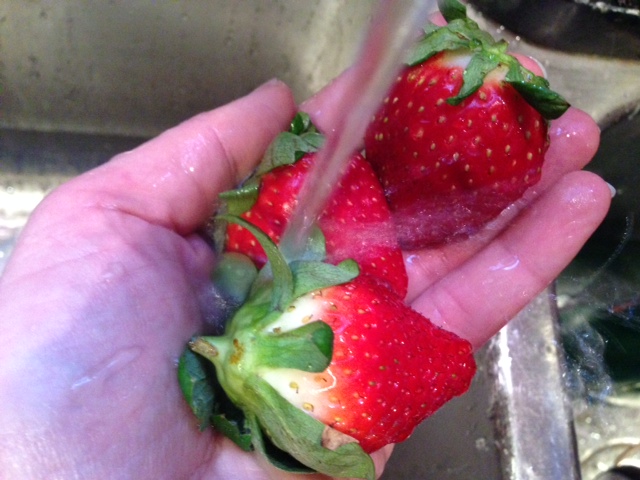
by Amy Mullins, PhD, RDN | Aug 24, 2015
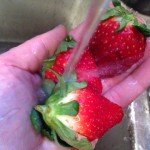 Are your kids famished when they get home from school? Kids often hit the kitchen right when they get home and begin the search for something to eat. After being at school all day, it’s inevitable they will bring a host of germs into the house (and into the kitchen). These germs, or microorganisms, can contaminate your kitchen and make your child sick if they are not kept in check.
Are your kids famished when they get home from school? Kids often hit the kitchen right when they get home and begin the search for something to eat. After being at school all day, it’s inevitable they will bring a host of germs into the house (and into the kitchen). These germs, or microorganisms, can contaminate your kitchen and make your child sick if they are not kept in check.
How can kids prepare after-school snacks in the safest way?
Establishing good habits and putting good practices in place can help keep your kids from getting a foodborne illness. The USDA recommends the following:
- Keep all items such as books, backpacks, and sporting equipment on the floor and off of kitchen counters and tables.
- Wash hands first when coming home from school, and again before making and eating a snack. Hands carry lots of germs and can easily contaminate everything they come in contact with.
- Wash fruits and vegetables under running water before eating them.
- Read more about “Food Safety After School”
What are some good after-school snacks?
Choosing easy and healthy snacks for kids can be a real challenge, especially when dealing with picky eaters. Typically, kids feel more independent when they have options and can control what they eat. Parents can set their children up for success by having a variety of healthy snack choices that are easily accessible. Find some great snacking ideas here. Keith Williams, PhD, director of the feeding clinic at the Penn State Hershey Children’s Hospital, recommends having plenty of fruits and vegetables already washed, cut up, and within easy reach of children. Keep the “sometimes” foods out of reach so you can control when your child eats them. “The goal is to make it easier to obtain the healthy snacks you want your child to eat and more difficult to obtain the foods you don’t want him to eat,” says Williams. Read more about “Breaking Your Gradeschooler’s Unhealthy Food Habit” here.
Establishing healthy habits from an early age can transition children into healthier adults. Learn more about making smart choices by visiting http://www.choosemyplate.gov/kids/
by Marjorie Moore | Jul 25, 2015
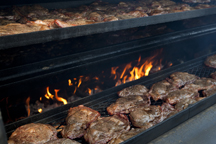
Photo Source: UF/IFAS Tyler Jones.
Summer brings on the craving to grill and that craving continues through the year! Millions of Americans will enjoy grilling as they gather with family and friends. Whether grilling outdoors or indoors, safe food handling is always important.
When shopping, pick up cold foods such as meat and poultry just before you checkout. Put these foods in plastic bags and keep separate from other foods in your cart. It is wise to have a cooler with ice in your car for all perishables but if not, plan to go directly home. Refrigerate or freeze meat and poultry promptly when you get home.
Thaw meat and poultry in the refrigerator and NEVER on the kitchen counter. For quicker thawing, thaw in the microwave and immediately place on the grill. Thaw meats, fish and poultry completely before grilling. If not thawed completely, the food will not cook evenly.
If marinating meats and poultry, do so in the refrigerator. USDA Food Safety and Inspection Service suggests that poultry and cubed meat may be marinated for up to 2 days and roasts, chops, and steaks marinated up to 5 days. If some of the marinade will be used as a sauce on the cooked food, reserve a portion before putting raw meat and poultry in it. However, if the marinade used on raw meat or poultry is to be reused, make sure to let it come to a boil first to destroy any harmful bacteria.
Use separate utensils, platters, and pans for raw and cooked meat and poultry. Raw juices are high in bacteria and could contaminate safely cooked food.
Never partially cook meat or poultry and save to continue cooking later on the grill. If you do pre-cook, cook these foods completely then cool, refrigerate and reheat later on the grill.
Cook meat such as steaks, roasts, and chops to 145°F. Ground meats such as beef, pork, veal and lamb cooked to 160°F. All poultry, whether whole, pieces or ground, should be cooked to 165°F. Fish and shellfish should be cooked to 145°F.
During the past few years, there have been a few concerns about grilled meats causing cancer.
Some research suggests there may be a cancer risk related to eating meat and poultry cooked by high-heat cooking techniques such as grilling, frying, and broiling. Current research suggest eating moderate amounts of grilled meats, fish, and poultry cooked to a safe temperature, without charring, does not pose a problem. Prevent charring by removing visible fat that can cause a flare-up. Meat can also be precooked immediately before placing on the grill, which helps to release some of the juices that can drop on coals.
So, keep on grilling, but keep your food safe!
Please click here to answer a few questions to help us better serve you.
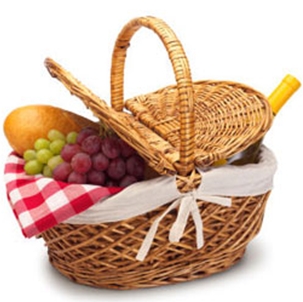
by Dorothy C. Lee | Jun 26, 2015
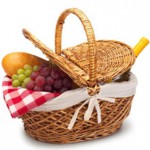 It’s that time of year…Summertime! What could be more enjoyable than a summer picnic? Along the Gulf Coast, all you need is a sunny day, white sand beach, and a menu to remember.
It’s that time of year…Summertime! What could be more enjoyable than a summer picnic? Along the Gulf Coast, all you need is a sunny day, white sand beach, and a menu to remember.
However, poor planning can turn a picnic into a small disaster, so first, check the weather forecast because a rainstorm can put a damper on your day.
Keep your food safe. Take only the amounts of food you will use. With a proper cooler and ice, most foods are safe for short periods of time. If you don’t have a cooler, some suggestions for non-perishable foods include fresh, canned, or dried fruits, raw vegetables, hard cheeses, canned or dried meats, crackers, and peanut butter.
Packing pointers: Safe packing of food is essential for picnicking safely. Starting with cold food, pack straight from the refrigerator or freezer into an insulated cooler. Package all foods in clear plastic wrap or zip-top bags. If you don’t have or want to use commercial ice packs, you can make your own by placing ice cubes in a plastic bag, then wrapping the bag in foil.
Sandwiches can be made ahead and frozen, but without veggies and condiments. Place frozen sandwiches in the cooler. They will thaw by lunchtime. Pack lettuce, tomato, and condiments in separate containers and add to sandwiches just before serving. Frozen small cans or boxes of juice, yogurt, or applesauce also will thaw by lunchtime.
Keep hot foods hot with insulated dishes or thermal containers. The rule to remember for safe foods is “Keep cold foods cold and hot foods hot.”
Once you arrive at the picnic site, don’t leave the cooler in the car or in direct sunlight – keep the cooler in the shade, keep the lid on, and avoid frequent openings. Consider using a second cooler just for drinks to reduce the exposure of food to warm air with each lid opening. Add more ice if it begins to melt. In extremely hot weather, food should not sit off refrigeration for more than one hour. Serve small portions so the food doesn’t stay out of the cooler too long.
If you plan to prepare food at the picnic site, keep food cold until you’re ready to cook it. Cook food completely at the site—no partial cooking ahead. Use a clean plate to serve cooked food. Always take care that raw meat juices don’t touch other foods.
Picnics are a great excuse to get together with family and friends. To picnic safely, plan ahead, pack foods carefully, and keep cold foods cold and hot foods hot. Then, relax and have fun!
For further information, contact:
Dorothy C. Lee, C.F.C.S.
UF IFAS Extension Escambia County
3740 Stefani Road
Cantonment, FL 32533-7792
(850) 475-5230
dclee@ufl.edu
by Shelley Swenson | Mar 29, 2015
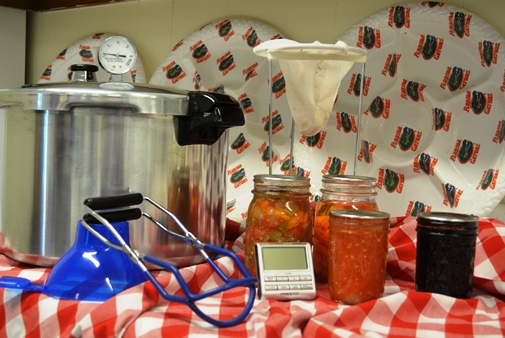
Get your pressure canner ready for the season.
Photo by Les Harrison, Wakulla County
In addition to planting your spring garden and reviewing the latest food safety materials, you should consider having your pressure canner gauge tested. Today’s pressure canner may have a dial gauge for indicating the pressure or a weighted gauge, for indicating and regulating the pressure.
Weighted gauges will either keep rocking gently or make a frequent jiggling noise to indicate that the correct pressure is being maintained. Read the manufacturer’s instructions to know how a particular weighted gauge should rock or jiggle. Weighted gauges do not require testing.
Check dial gauges for accuracy before use each year. Gauges that read high cause under-processing and may result in unsafe food. Low readings cause over-processing. Pressure adjustments can be made if the gauge reads up to 2 pounds high or low. Replace gauges that differ by more than 2 pounds.
Many UF/IFAS Extension Offices have pressure gauge testers and are willing to test yours for accuracy. It is always best to call for an appointment to insure that the FCS Agent is going to be in when you arrive. Don’t remove the gauge but bring the entire lid. If you prefer or if you find that your extension office does not offer this service, Presto will test gauges at no charge. For more information, phone Presto Customer Service: 1-800-877-0441 or contact@gopresto.com.
Handle canner lid gaskets carefully and clean them according to the manufacturer’s directions. Nicked or dried gaskets will allow stem leaks during pressurization of canners. Keep gaskets clean between uses. Gaskets on older model canners may require a light coat of vegetable oil once per year. Gaskets on newer model canners are pre-lubricated and do not benefit from oiling. Check you canner’s instructions if there is doubt that the particular gasket you use has been pre-lubricated.
Lid safety fuses are thin metal inserts or rubber plugs designed to relieve excessive pressure from the canner. Do not pick at or scratch fuses while cleaning. Use only canners that have the Underwriter’s Laboratory (UL) approval to ensure their safety.
Replacement gauges and other parts are often found at stores that sell food preservation equipment or from canner manufacturers. When ordering parts, be sure to provide your canner model number and describe the parts that you need.
Remember, pressure does not destroy microorganisms, but high temperatures applied for an adequate period of time do kill microorganisms. The success of destroying all microorganisms capable of growing in low-acid, canned food is based on the temperature obtained in pure steam, free of air, at sea level. At sea level, a canner operated at a gauge of 10.5 pounds provides an internal temperature of 240o.
For more information, contact your County Extension Family and Consumer Sciences Agent.
by Dorothy C. Lee | Mar 17, 2015

Egg food safety at Easter time
Easter activities often include eggs. During the Spring holiday, eggs are both a decorative craft object and an inspiration for springtime fun and games, and, oh by the way, they are fun to eat too.
Eggs and egg products can be an important part of your diet. Although there are many myths and misconceptions about how to safely cook and handle eggs, all it really requires is care. By following a few simple guidelines, eggs and egg products can play a valuable and economic role in your holiday menu.
To avoid the possibility of foodborne illness, fresh eggs must be handled carefully. Even eggs with clean, uncracked shells may occasionally contain bacteria called Salmonella that can cause an intestinal infection. The U.S. Food and Drug Administration (FDA) is working to prevent this problem in eggs by requiring that egg producers obtain chicks that are certified Samonella-free, that the hens are kept in houses that are free from rodents and other Salmonella carrying sources, that the houses are continually tested for Salmonella, and that the eggs are stored at temperatures that retard Salmonella growth. Consumers play a large role in this prevention strategy. In fact, the most effective way to prevent egg-related illness is by knowing how to buy, store, handle and cook eggs—or foods that contain them—safely.
Following these instructions is important for everyone, but especially for those most vulnerable to foodborne disease—children, the elderly, and persons with weakened immune systems.
Buy Right
- Buy eggs only if sold from a refrigerator or refrigerated case.
- Open the carton and make sure that the eggs are clean and the shells are not cracked.
- Refrigerate promptly.
- Store eggs in their original carton and use them within 4 to 5 weeks.
Keep Everything Clean
Before preparing any food, remember that cleanliness is key!
- Wash hands, utensils, equipment, and kitchen work surfaces with hot, soapy water before and after they come in contact with eggs and egg-containing foods.
Cook Thoroughly
Cook eggs thoroughly. Thorough cooking is perhaps the most important step in making sure eggs are safe.
- Cook eggs until both the yolk and the white are firm. Scrambled eggs should not be runny.
Serve Safely
Bacteria can multiply in temperatures from 40°F (5°C) to 140°F (60°C), so it’s very important to serve foods safely.
- Serve cooked eggs and egg-containing foods immediately after cooking.
- For buffet-style serving, hot egg dishes should be kept hot, and cold egg dishes kept cold.
- Eggs and egg dishes, such as quiches or soufflés, may be refrigerated for serving later but should be thoroughly reheated to 165°F (74°C) before serving.
Chill Properly
- Cooked eggs, including hard-boiled eggs, and egg-containing foods should not sit out for more than 2 hours. Within 2 hours, either reheat or refrigerate.
- Use hard-cooked eggs (in the shell or peeled) within one week after cooking
On the Road
- Cooked eggs for a picnic should be packed in an insulated cooler with enough ice or frozen gel packs to keep them cold.
- Don’t put the cooler in a hot car—carry it in the air-conditioned passenger compartment of the car.
Safe Handling Instructions
To prevent illness from bacteria: keep eggs refrigerated, cook eggs until yolks are firm, and cook foods containing eggs thoroughly.
Hard-cooked Easter eggs can help stretch your food dollars. Packed with high-quality protein, vitamins, and minerals, they add good nutrition when included in casseroles, sandwiches, and salads. Remember, hard-cooked eggs should be refrigerated as much as possible between cooking, decorating, and the hunt or the display.
However they are used, eggs are delicious, nutritious, and economical.
For further information, contact
Dorothy C. Lee, C.F.C.S.
Family & Consumer Sciences Agent
UF IFAS Extension Escambia County
(850) 475-5230
dclee@ufl.edu
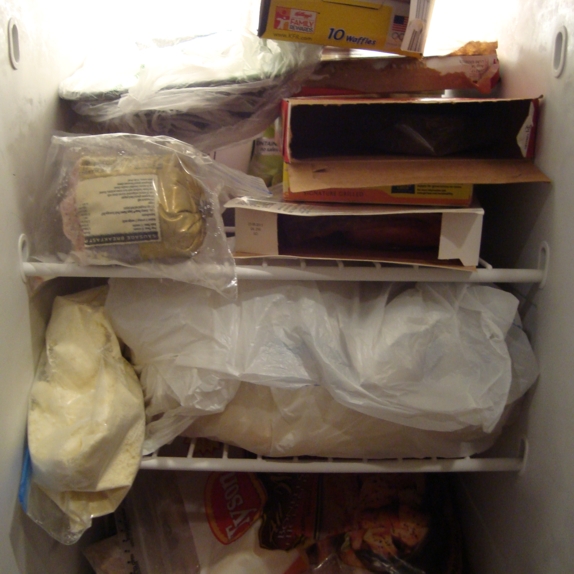
by Angela Hinkle | Mar 13, 2015
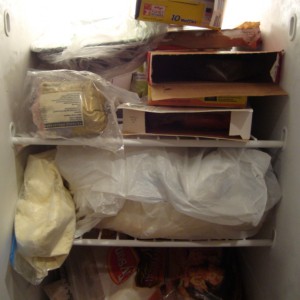
UFOs in Your Freezer
Does your kitchen freezer resemble an archaeological dig in an iceberg? Do you ever see what you think is what you’re looking for in the very back? As you reach for it, half of everything else falls out onto your kitchen floor? UFOs (Unidentified Frozen Objects) end up everywhere. Your reaction may be something like, “*#@&!”
This may be a sign that it’s time to organize your freezer. “Are you kidding me? Who has time for that?,”’ you may ask. You might even roll your eyes.
Here are a few tips that may help:
- Clean it out and when in doubt, throw it out.
Start with the hardest part first – trust me, it gets much easier after you’ve completed this step. Go through all the contents of your freezer and throw out what is freezer-burned or otherwise unusable. If you really have no idea if it’s animal, mineral, or vegetable, or how long it’s been in your freezer, it’s time to toss.
If you’ll take a quick moment to label and date the food before you put it in the freezer, you’ll save your sanity later by avoiding guess work. (A friend told me she pulled the plastic tub of fundraiser cookie dough out of the freezer as a treat for her kids. What a surprise to be treated instead to vegetable stew.) Label using wax crayons, pencil, or marker pens on stickers or tape that can stay put in freezing temperatures. And yes, if you are so inclined, there are apps for labeling. By the way, the sniff test is usually useless, since most frozen foods won’t have much of an aroma.
- Freeze in useable portions.
Congratulations! You saved money buying the chicken in that family-sized pack. Keep food safe and manageable by individually wrapping pieces, then freezing in a large, labeled, plastic zip-type bag. Then you only take out the amount you want. You may lose more money than the original savings if you have to thaw out and possibly throw out a gigantic clump of chicken because you only wanted enough for two. Smaller packages also freeze and thaw faster, which saves you time.
Pancakes, berries, broths, meats, nuts, chilies and stews, flour, shrimp, and fish are good choices for freezing. These foods are structurally sound enough to survive the freezer. On the other hand, you’ll want to avoid freezing high-moisture fruits and vegetables like lettuce and watermelon, yogurt, and fried foods. Their textures and appearance tend to turn to, well, yuck.
- Choose the best containers.
We need air to breath, not to circulate around our frozen foods. Air circulating around frozen food can lead to freezer burn – which often makes the food dry and tough. Find containers close to the size of the food you want to freeze. Also, freezing food flat in plastic zipper bags makes them easy to stack.
Remembering to use these tips should help de-stress your life … at least a little. So the next time you’re asked, “What’s for dinner?,” your reply won’t have to be, “We’re having the UFO that fell on my foot.”
For more information on freezing foods, contact your local UF/IFAS Extension Office at http://directory.ifas.ufl.edu/Dir/searchdir?pageID=3&pl=05 and check out these UF/IFAS publications on freezing fruits, http://edis.ifas.ufl.edu/pdffiles/FY/FY72000.pdf, and freezing vegetables, http://edis.ifas.ufl.edu/pdffiles/FY/FY71900.pdf

 Are your kids famished when they get home from school? Kids often hit the kitchen right when they get home and begin the search for something to eat. After being at school all day, it’s inevitable they will bring a host of germs into the house (and into the kitchen). These germs, or microorganisms, can contaminate your kitchen and make your child sick if they are not kept in check.
Are your kids famished when they get home from school? Kids often hit the kitchen right when they get home and begin the search for something to eat. After being at school all day, it’s inevitable they will bring a host of germs into the house (and into the kitchen). These germs, or microorganisms, can contaminate your kitchen and make your child sick if they are not kept in check.






